
Tortoises are reptiles of the family Testudinidae of the order Testudines. Like other turtles, tortoises have a shell to protect from predation and other threats. The shell in tortoises is generally hard, and like other members of the suborder Cryptodira, they retract their necks and heads directly backward into the shell to protect them.

The Geoemydidae are one of the largest and most diverse families in the order Testudines (turtles), with about 70 species. The family includes the Eurasian pond and river turtles and Neotropical wood turtles. Members of this family are commonly called Leaf turtle.

Testudo, the Mediterranean tortoises, are a genus of tortoises found in North Africa, Western Asia, and Europe. Several species are under threat in the wild, mainly from habitat destruction.

Gopherus is a genus of fossorial tortoises commonly referred to as gopher tortoises. The gopher tortoise is grouped with land tortoises that originated 60 million years ago, in North America. A genetic study has shown that their closest relatives are in the Asian genus Manouria. The gopher tortoises live in the southern United States from California's Mojave Desert across to Florida, and in parts of northern Mexico. Gopher tortoises are so named because of some species' habit of digging large, deep burrows. Most notably, Gopherus polyphemus digs burrows which can be up to 40 feet (12 m) in length and 10 feet (3.0 m) in depth. These burrows are used by a variety of other species, including mammals, other reptiles, amphibians, and birds. Gopher tortoises are 20–50 cm (7.9–19.7 in) in length, depending on the species. All six species are found in xeric habitats. Numerous extinct species are known, the oldest dating to the Priabonian stage of the Late Eocene of the United States.

Geochelone is a genus of tortoises.
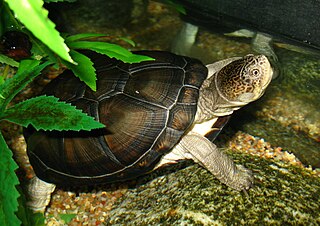
Pelusios is a genus of African side-necked turtles. With 17 described species, it is one of the most diverse genera of the turtle order (Testudines).
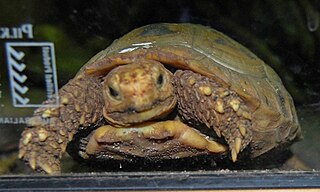
Indotestudo is a genus of tortoise from South and Southeast Asia. in the family Testudinidae. The three species in the genus are all threatened.

The yellow-footed tortoise, also known as the Brazilian giant tortoise, commonly referred to as the Brazilian giant turtle, or more commonly, the big turtle, is a species of tortoise in the family Testudinidae and is closely related to the red-footed tortoise. It is found in the Amazon Basin of South America. The species name has often been misspelled as denticulata, an error introduced in the 1980s when Chelonoidis was elevated to genus and mistakenly treated as feminine, an error recognized and fixed in 2017.
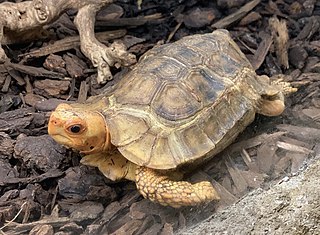
The forest hinge-back tortoise, also known commonly as the serrated hinge-back tortoise or Schweigger's tortoise, is a species of tortoise in the family Testudinidae. The species is indigenous to the tropical forests and marshes of central and western Africa.
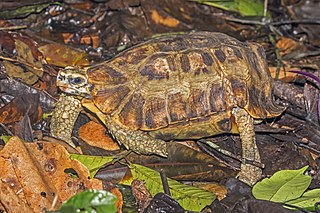
Home's hinge-back tortoise is a species of tortoise in the family Testudinidae. The species is endemic to Africa.

The Natal hinge-back tortoise, also known as Natal hinge-backed tortoise or Natal hinged tortoise, is a species of tortoise in the family Testudinidae which is restricted to eastern southern Africa to a relatively small area around the borders of Mozambique, South Africa, and Eswatini.
The variable mud turtle, also known as Rhodesian mud turtle, Mashona hinged terrapin or variable hinged terrapin, is a species of turtle in the family Pelomedusidae. It is widely distributed in Central, East, and Southern Africa. The species was officially described by John Hewitt in 1927 and had to be broken into subspecies due to color variations on the heads of the turtles acrost the regions.

Bell's hinge-back tortoise, also known commonly as Bell's eastern hinged tortoise, is a species of tortoise in the family Testudinidae. The species is native to central Africa. It has the hinge that characterizes all tortoises in the genus Kinixys. There are no recognized subspecies.

August Friedrich Schweigger was a German naturalist born in Erlangen. He was the younger brother of scientist Johann Salomo Christoph Schweigger (1779-1857).

The serrated tortoise German: Kalahari-Strahlenschildkröte is a species of tortoise that occurs in the Kalahari desert regions of southern Africa. Also known as the Kalahari tent tortoise, it is one of three members of the genus, Psammobates.
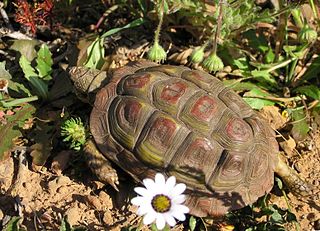
Homopus areolatus, commonly known as the common padloper or parrot-beaked tortoise, is a tiny species of tortoise of the genus Homopus, indigenous to the southern part of South Africa.

Speke's hinge-back tortoise, also known commonly as Speke's hingeback tortoise, is a species of turtle in the family Testudinidae. The species is endemic to Africa.
The Lobatse hinge-back tortoise or Lobatse hinged tortoise is a species of turtle in the family Testudinidae. It is found in Southern Africa.


















